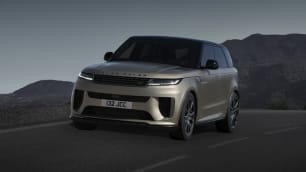Before driving the Sport SV you need to understand its highly complex suspension system that allows it to be so dynamically capable. Range Rover calls it a '6D Dynamic' system, because it can control the car left and right, up and down and corner to corner.
To achieve this the system uses a combination of hydraulic interlinked dampers, height-adjustable air springs and pitch control, which makes it a semi-active suspension set-up similar to the set-up Formula 1 race cars used to boast.
This allows the Sport SV to sit between 10-25mm lower than the other Sport models and with its clever suspension can actually sit flatter in the corner with less pitch and roll - which is the traditional enemy of high-riding SUVs when it comes to handling.
But the suspension is only part of the story, with the intelligent all-wheel drive, rear-wheel steering, torque vectoring and the active locking rear diff all combining to produce an SUV with incredibly impressive dynamic capability.
Put simply, there’s never been a Range Rover that deserved to be driven on a racetrack. The Sport SV changes that, and thankfully the company let us loose on the challenging Portimao circuit in Portugal to put the SV through its paces.
Range Rover management was quick to stress it doesn’t expect the Sport SV to be a race track regular for its owners, but driving it on track did highlight the extreme potential it offers.
With such a powerful engine it should come as no surprise that the Sport SV hauled down the straight, hitting 233km/h at the end of the long front straight, but with speed still rising which suggests its 290km/h claimed top speed is accurate.
Even from those speeds and with 2560kg of SUV to slow down, with the carbon ceramic brakes it was no trouble whatsoever. Instead the braking was strong and consistent across multiple laps.
The steering is the particular highlight, with the rear-wheel steering helping to turn the Sport SV sharper and more quickly than a big SUV like this should.
But while it impressed on the circuit, we also experienced it on some great winding rural roads across Portugal and this is where it shone even more brightly.
This is an SUV that you’ll genuinely enjoy driving with its ability to carve through corners and blast down anything resembling straight road.
But to ensure it lives up to the Land Rover badge on the front, we also drove it off-road. Nothing too serious at first, just muddy ruts, across some water and over some rocks.
But then we were guided through a course that showed off its articulation potential, which is far greater than the average owner will ever need.
However, to achieve this Range Rover removed the carbon-fibre front splitter, so it’s not the most off-road friendly model the brand offers.

